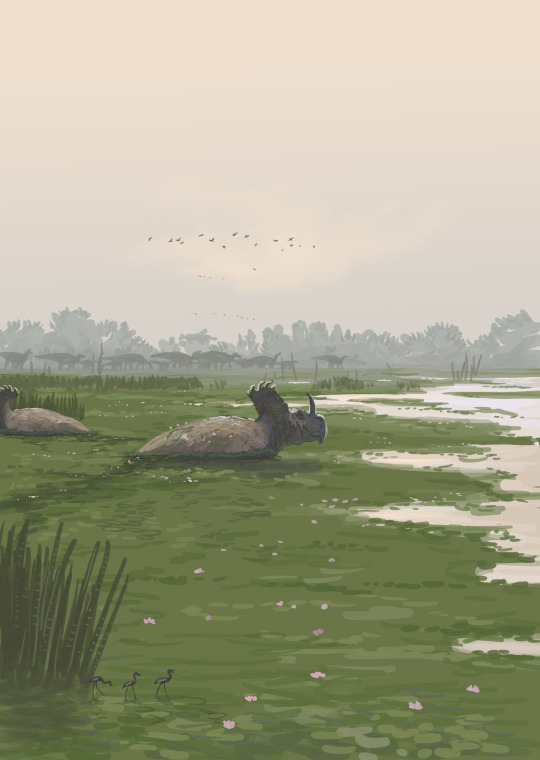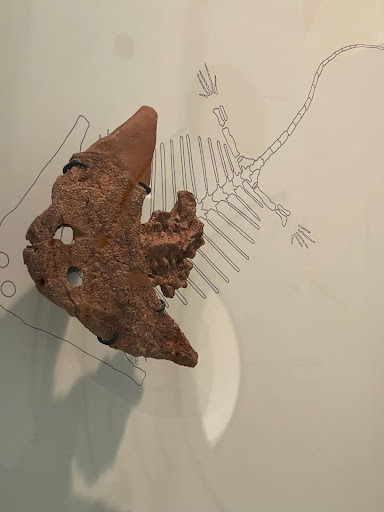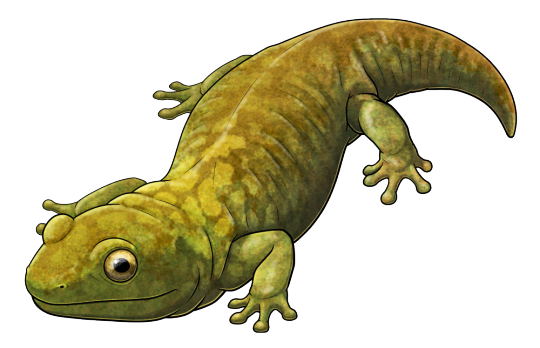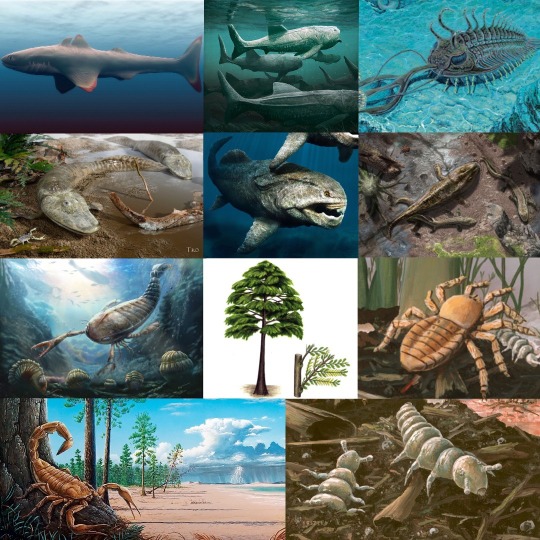#tetrapod
Explore tagged Tumblr posts
Text

Cat on a tetrapod by pelican https://bit.ly/45zoOam https://flic.kr/p/2qZwDCz Uploaded April 24, 2025 at 10:57PM
20 notes
·
View notes
Text




Results from the #paleostream!
Gaiasia, Burnetia, Sinoceratops and Hemipsalodon
#paleoart#sciart#paleostream#palaeoblr#cretaceous#dinosaur#sinoceratops#therapsid#tetrapod#permian#oligocene
347 notes
·
View notes
Text

Tetrapod from Cell to Singularity
1K notes
·
View notes
Text

Anthracodromeus longipes was an early reptile* that lived in what is now Ohio, USA, during the late Carbonifeorus about 307-305 million years ago.
(*or possibly a very reptile-like stem-amniote)
Around 20cm in total length (~8"), it had a rather lizard-like shape with a long body and a short tail. The digits on all four of its limbs were highly elongated with hooked claws, which appears to have been an adaptation for climbing.
It inhabited a coal forest dominated by lycopsid trees and seed ferns, and as one of the earliest known tetrapods to develop climbing behavior it would have had some ecological advantages over its relatives, being better able to escape from predators and access new food sources.
———
NixIllustration.com | Tumblr | Patreon
References:
Carroll, R. L., and Baird, D. "Carboniferous stem-reptiles of the family Romeriidae." Bulletin of The Museum of Comparative Zoology 143 (1972): 321–363. https://archive.org/details/biostor-696/mode/2up
Mann, Arjan, et al. "Digit and ungual morphology suggest adaptations for scansoriality in the late Carboniferous eureptile Anthracodromeus longipes." Frontiers in Earth Science 9 (2021): 675337. https://doi.org/10.3389/feart.2021.675337
Simões, Tiago R., et al. "Successive climate crises in the deep past drove the early evolution and radiation of reptiles." Science Advances 8.33 (2022): eabq1898. https://doi.org/10.1126/sciadv.abq1898
Wikipedia contributors. “Anthracodromeus” Wikipedia, 09 Jun. 2024, https://en.wikipedia.org/wiki/Anthracodromeus
130 notes
·
View notes
Text

Happy Fossil Friday! This boomerang-headed critter is Diplocaulus magnicornis. It lived some 275 million years ago during the Early Permian in what is now Baylor County, Texas. Like other nectrideans (an extinct order of tetrapods), this species had two projections at the back of its skull, creating its signature boomerang shape. Scientists aren’t sure what its exact function was, but it was presumably related to the way the animal swam. Diplocaulus probably lived in ponds and streams.
Photo: M. Pelczar / © AMNH
#science#amnh#fossil#museum#paleontology#nature#natural history#animals#dyk#boomerang#fossil friday#tetrapod
602 notes
·
View notes
Text

Jumy-M Tetrapod vs. Raging waves / 消波ブロック対荒波
297 notes
·
View notes
Text

Tetrapod (structure)
“Tetrapods on Graciosa Island, Azores” - via Wikimedia Commons
#tetrapod#concrete#Wave-dissipating concrete block#breakwater#breakwater element#wikipedia#wikipedia pictures#wikimedia commons#engineering#erosion prevention#erosion#shoreline erosion#coastal#coastal shoreline#shoreline#photography
39 notes
·
View notes
Text

Results from todays flocking paleostream
We did Gaiasia

Pelagornis

Platyhystrix

And Astrodon
#paleoart#art#paleontology#gaiasia#amphibian#temnospondyl#tetrapod#pelagornis#baby albatross#Platyhystrix#astrodon#tooth genus#womp womp#toadlet#time travel#ing#butterfly#sciart#flocking#paleostream
144 notes
·
View notes
Text

The Paleo Party Guest of the day is Rhizodus!
This lobe-finned fish technically qualifies as a stem tetrapodomorph! They may also be one of the largest of their family, capable of growing up to 18 ft long.
Age: 346-323mya
Location: UK and Russia
Stickers || Phone Wallpapers Masterlist
45 notes
·
View notes
Text

tetrapods concrete
37 notes
·
View notes
Text
Early tetrapod paludarium

#biology#dinosaur#dinosaur art#dinosaurs#fossils#geology#mesozoic#palaeoart#palaeontology#paleoart#devonian#scientific illustration#sciart#paleozoo#paleontology#tetrapod#tiktaalik#ichthyostega#science#zoo#aquarium#oceanarium#terrarium#paludarium
226 notes
·
View notes
Text

Artillery Mech
Had more mechs on the mind, this time inspired by the designs of the Gen 5 Armored Cores (from V and Verdict Day)!
62 notes
·
View notes
Text

Seduced by the blue of the sea...
60 notes
·
View notes
Text

Despite being named after the famous Muppet frog, Kermitops gratus here wasn't actually a frog itself. Instead it was a close relative of the common ancestor of all modern amphibians, part of a grouping of amphibian-like animals known as amphibamiform temnospondyls.
Living in what is now Texas, USA, during the mid-Permian, about 275 million years ago, Kermitops would have resembled a chunky salamander. Only its fossil skull is known, so its full body size is uncertain, but based on the proportions of related amphibamiformes it was probably around 15-20cm long (~6-8").
Although its discovery helps to fill in the very sparse fossil record of the early evolution of modern amphibians, it's also complicated matters more than expected. Previously it was thought that the characteristic skull anatomy of modern amphibians evolved in a clear sequence, but Kermitops has a unique mix of features that doesn't fit this idea – suggesting that there was a lot of convergent evolution going on in amphibamiformes at the time.
———
NixIllustration.com | Tumblr | Patreon
#science illustration#paleontology#paleoart#palaeoblr#kermitops#amphibamiformes#dissorophoidea#temnospondyl#amphibian#stem-lissamphibian#tetrapod#art#it's not easy bein' green#somebody name an entelodont after miss piggy next please
397 notes
·
View notes
Photo

More of the Alternate Form Project - here is Turpis the totally not demon's monster form. I based it off an old sketch of him plus prehistoric amphibian relatives, with a side of Toothless from the How To Train Your Dragon movies
6 notes
·
View notes
Text
Life in the Devonian

(first row: Cladoselache, Titanichthys, Walliserops; second row: Tiktaalik, Dunkleosteus, Ichthyostega; third row: Jaekelopterus, Archaeopteris, Paleocharinus; fourth row: Gondwanascorpio, Ryniella)
Art by:
Walliserops - Richard A. Fortey (The lifestyles of the trilobites)
Cladoselache -Christian Darkin
Tiktaalik - Ntvtiko
Ichthyostega - Davide Bonadonna
Dunkleosteus - Robert Fabiani
Titanichthys - Mark Witton
Jaekelopterus - Dani Navarro
Archaeopteris - Annette Townsend
Gondwanascorpio - Ariel Milani Martine
Ryniella, Paleocharinus - Bizley Art
Welcome to the Age of Fish!
Whatever you‘re looking for, we have the right fish for you. May I interest you in some early shark-cousins like Cladoselache? Or maybe you prefer bony fish over cartilaginous ones. In that case you‘re in luck because they now come in two brand new varieties: The ray-finned fish and the lobe-finned fish. As you might have suspected, their fins work differently: Ray-finned fish have bony spines covered by skin, that form a fan-like fins. Today they make up almost 99 % of fish species and more than 50 % of all vertebrate species. So if you‘re picturing any type of fish right now, that is probably a ray-finned fish.
The only lobe-finned fish that are still around today are the coelacanths and lungfish, but during the Devonian they were much more common. They have fleshy fins that have an extra bone that separates the actual fin-part from the rest of the body.
But before I talk more about fins with extra bones, let‘s give the spotlight to the real stars of the Devonian: The Placoderms. The “armored fish“ got their name from the bony plates that cover their head. They had jaws (and were the first vertebrates to do so), but no real teeth. However, in many species their bony armor had self-sharpening edges at the mouth, that were used similar to teeth (and honestly, that sounds somehow more terrifying than actual teeth).
Although most of them were mid-sized, the biggest ones like Dunkleosteus and Titanichthys reached sizes similar to a modern white shark (4-6 m), maybe even bigger. Titanichthys is assumed to be a filter feeder, while Dunkleosteus was an active hunter marking the first time vertebrates took over the roles of apex predators.
Placoderms in general were pretty big on being the first vertebrates to do things: They were among the first to colonize the open ocean as well as freshwater (I don‘t spend enough time appreciating that water is not just water, but has tons of different habitats). They were also the first ones to have clasper-like structures, which is the fish version of a penis. With that they were able to have internal fertilization or, as the non-scientist call it, sex. Before the placoderms came around, vertebrates weren‘t doing that. Related to that, placoderms are the oldest known case of an animal giving live birth.
One more cool thing about placoderms is that they are the oldest known case of fossilized pigment in vertebrates. Personally, I absolutely love everything that has to do with coloration in prehistoric animals, so I will bring it up as often as I possibly can. This particular fish supposedly had a silvery iridescent belly and a red-ish back. Not only is this cool, because that‘s a very pretty fish, but also because it might hint towards placoderms having color vision.
Since the placoderms were terrorizing the oceans, some of those lobe-finned fish I talked about had quite a bit of motivation to get away from them. This is where those extra bones I mentioned came in handy, because they evolved into leg-like structures. Air bladders, which were originally used for buoyancy, were repurposed into lungs for breathing. This new group of vertebrate was able to invade the land. Animals like Ichthyostega and Tiktaalik were among the very first tetrapods (that translates to “four legs“), a group that today includes amphibians, reptiles, birds and mammals (that‘s us!).
The tetrapods were however not the first life on land, in fact they were pretty late to the party. By this time there were already many plants on land, including the very first trees like Archeopteris, the very first insects, scorpions and other arachnids like Paleocharinus (which is not a true spider, but a close cousin. Reading about them did however gave me a nightmare, so it‘s close enough to spiders to trigger my arachnophobia).
The last mention should probably go to Jaekelopterus, the biggest eurypterid (“sea scorpion“), and therefore biggest arthropod ever, with a size of over 2.5 m. Just imagine a fucking 2.5 me long bug. I kinda hate it. And I‘m impressed.
12 notes
·
View notes